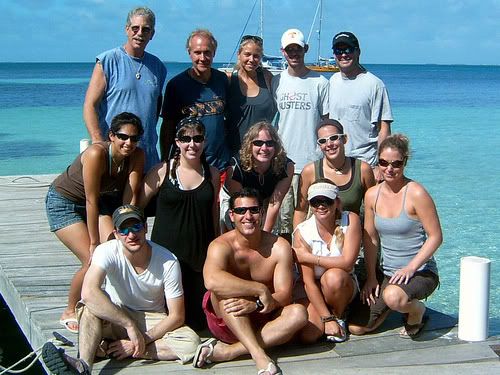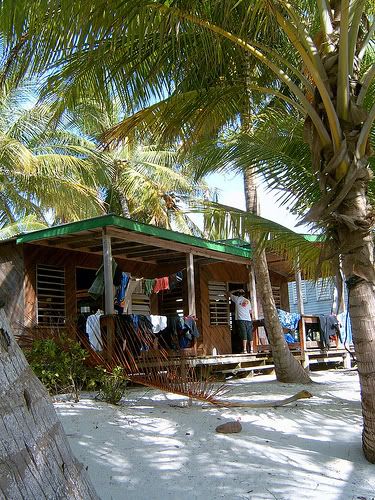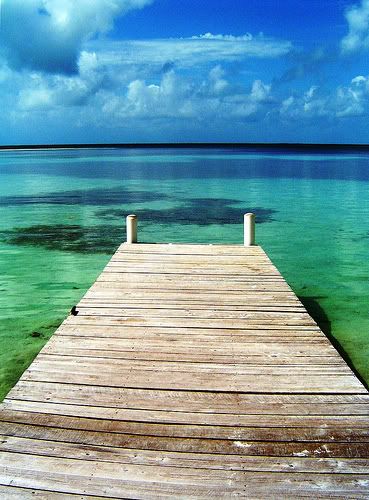 The trip began on Saturday, March 29 with me, our professor, the TA and eight of my local classmates flying out of Miami International Airport into Belize City, Belize. Once in the country we rendezvoused with two distance students, and took a single engine Cessna on a 15 min flight to Dangriga, Belize. From there we piled tightly into a bus on a short trip to the boat that would take us to our final destination. The boat delivered us to the IZE resort on South Water Caye, an island 16 miles off the coast and within a stone’s throw of the second longest coral reef system in the world. (Group on South Water Caye, photo credit: Katie Shade)
The trip began on Saturday, March 29 with me, our professor, the TA and eight of my local classmates flying out of Miami International Airport into Belize City, Belize. Once in the country we rendezvoused with two distance students, and took a single engine Cessna on a 15 min flight to Dangriga, Belize. From there we piled tightly into a bus on a short trip to the boat that would take us to our final destination. The boat delivered us to the IZE resort on South Water Caye, an island 16 miles off the coast and within a stone’s throw of the second longest coral reef system in the world. (Group on South Water Caye, photo credit: Katie Shade) Our living arrangements for the week consisted of two connected “cabins,” cold showers, and a communal dining hall. On either side of our compound were resorts with easier access to the reef. We began work early Sunday with a snorkel in the area south of the island. After our lunch our task was to map that part of the reef and document the dominant species of fishes, corals, algae, and invertebrates in each zone of the reef. Using one of my classmate’s GPS unit we were able to easily map the area. Everyone else worked to document the species on the reef. And by 9pm we had finished collecting and organizing our data. (Our Cabin, photo credit: Katie Shade)
Our living arrangements for the week consisted of two connected “cabins,” cold showers, and a communal dining hall. On either side of our compound were resorts with easier access to the reef. We began work early Sunday with a snorkel in the area south of the island. After our lunch our task was to map that part of the reef and document the dominant species of fishes, corals, algae, and invertebrates in each zone of the reef. Using one of my classmate’s GPS unit we were able to easily map the area. Everyone else worked to document the species on the reef. And by 9pm we had finished collecting and organizing our data. (Our Cabin, photo credit: Katie Shade)In addition to our mapping we also had the responsibility to read a few scientific papers everyday. Someone would then be chosen to present a summary of the paper to the class. On Monday, we took a boat out to the fourth cut south of our position. While at “Fourth Cut” we were able to see all the parts of the reef: from the peaceful back reef and lagoon to the more violent reef crest and even the tongue and groove structure of the deeper fore reef.
That afternoon, we took a boat out to the Smithsonian lab on Carrie Bow Cay, and traveled even further south to an area called Whale Shoals, which we mapped in a similar fashion as the reef on Sunday. That evening was filled with the fun and sometimes taxing work of identifying fishes, corals, sponges, and (for me) algae.
After working so efficiently together we were rewarded with a morning to catch up on our reading and have a little free time. Some people walked around the island, some went ocean kayak, and some (me included) decided to attempt to snorkel off the west side of the island. The tide was low and the back reef area was only knee deep at best. My three fellow classmates and I made it to the reef crest and, dodging the fire coral, were able to swim out to the fore reef. We spent a little while swimming about and decided to go back to shore. We were too far north to swim to the easy access on the south of the island so we decided to head back the way we came. Finding a groove in the reef crest I swam forward with waves crashing above and rocking me forward and back. In only a couple feet of water I had to grab hold of the fire coral (thankfully we all wore our dive gloves) to keep from being thrown about. We made it out but everyone had his or her own little scrape or damage from our little outing.
That afternoon the entire class went slopping through the deep mud of the mangroves. If you like hot, deep sulfur smelling mud, then the mangrove swamps are for you. We rinsed off with a snorkel in the channel that cuts through the mangroves and found many interesting juvenile fishes, sponges and even upside-down jellyfish.
 Wednesday, most of the class went on an all day scuba diving trip to Glover’s Reef, an atoll 26 miles off the coast. We made three dives and saw hawksbill turtles, a field of garden eels, schools of blue chromis and a nurse shark, among many other species. (Underwater View, Whale Shoals, photo credit: Erik DeMicco)
Wednesday, most of the class went on an all day scuba diving trip to Glover’s Reef, an atoll 26 miles off the coast. We made three dives and saw hawksbill turtles, a field of garden eels, schools of blue chromis and a nurse shark, among many other species. (Underwater View, Whale Shoals, photo credit: Erik DeMicco)Thursday, was reserved for our individual projects. Everyone did their own data collection on things like grazing rates, fish behavior, diurnal/nocturnal assemblage changes, etc. I helped a classmate mark off a patch reef and do a fish count. He then helped me to mark off a 3,000 m2 where I looked for a damselfish called a Beaugregory guarding eggs in discarded queen conch shells.
That night we geared up for a night snorkel. We found many sleeping parrotfish, squirrelfish on the prowl and an enormous number of invertebrates out on the reef. Squid, shrimp, and amphipods were everywhere. They were attracted to our lights and in some places cut visibility to under a foot. In most places we could see clearly and catch glimpses of animals like slipper lobsters that stay hidden during the day. At the end of the dive we found that leptocephalus (tarpon larvae) and mantis shrimp larvae had started washing up on shore.
Our final full day included us traveling back to the mainland and through Belmopan, the capital, and finally arriving at the Radisson in Belize City. It wasn’t safe to leave the hotel after dark, but the hotel had a bar and that’s really what most biologists are searching for anyway.
 On Saturday, we travelled back to the states. One of the girls and I had been booked on an earlier flight so we made our way back by ourselves via the TriRail and my friends at work. Overall, this trip was probably the highlight of my Nova career. I saw a fairly healthy coral reef first hand and the amazing abundance of life on the reef. I made some good friends and learned a good deal. I only wish that it could have lasted longer. (The Pier, South Water Caye, photo credit: Katie Shade)
On Saturday, we travelled back to the states. One of the girls and I had been booked on an earlier flight so we made our way back by ourselves via the TriRail and my friends at work. Overall, this trip was probably the highlight of my Nova career. I saw a fairly healthy coral reef first hand and the amazing abundance of life on the reef. I made some good friends and learned a good deal. I only wish that it could have lasted longer. (The Pier, South Water Caye, photo credit: Katie Shade)-------------------
Other photos from the trip can be viewed here

7 comments:
Did you not take any photos?
I only took a few pictures (none of which were as good as Katie's and Erik's), but since my classmates all had underwater cameras, I took the lazy route and let them get all the good shots.
God, that was such a great trip... :) It was so nice to go and so nice to get to know you better :)
Matt - Thanks for the photo credit. The Belize class was a great chance to see the largest coral reef in the western hemisphere. I had a blast. Best Regards, Erik
it absolutely is not that dangerous to leave the hotel after dark! trust me, i live there =)
Wonderful Story. Beautiful Pix. Hey (Umiabze) Could you please contact me, (pipelineboy@gmail.com) i,m planning on visiting Belize this year and have many questions about extending my stay there.
It looks so good in the post.
Many thanks for your nice posting, I like it.
Bathmate
Post a Comment